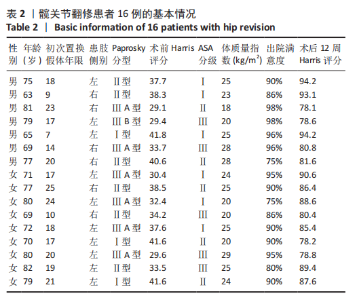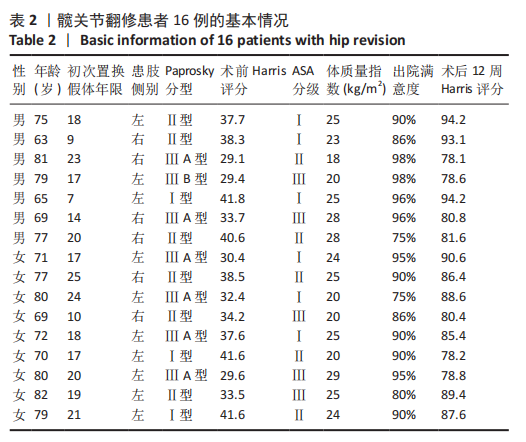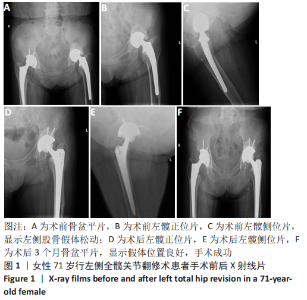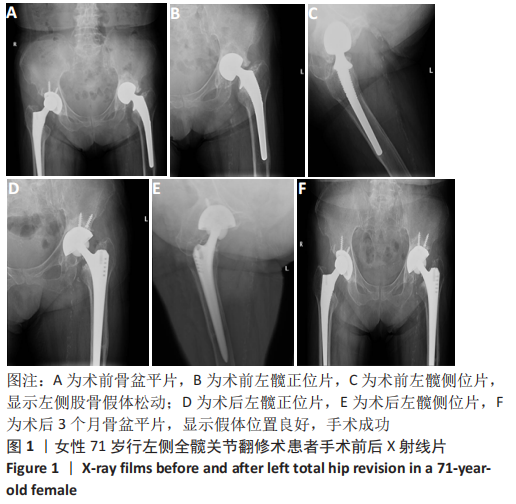[1] 胡海贝,周建生.全髋关节置换术中髋臼假体定位的研究进展[J].创伤外科杂志,2016,18(3):182-184.
[2] 裴福兴.髋关节翻修术若干问题探讨[J].中华外科杂志,2009,47(3):161-163.
[3] KONOPKA JF, LEE YY, SU EP, et al. Quality-Adjusted Life Years After Hip and Knee Arthroplasty: Health-Related Quality of Life After 12,782 Joint Replacements. JBJS Open Access. 2018;3(3):e0007.
[4] SWARUP I, LEE YY, CHIU YF, et al.Implant Survival and Patient-Reported Outcomes After Total Hip Arthroplasty in Young Patients. J Arthroplasty. 2018;33(9):2893-2898.
[5] FALDINI C, STEFANINI N, FENGA D, et al.How to prevent dislocation after revision total hip arthroplasty: a systematic review of the risk factors and a focus on treatment options. J Orthop Traumatol. 2018;19(1):17.
[6] WRIGHT EA, KATZ JN, BARON JA, et al. Risk factors for revision of primary total hip replacement: results from a national case-control study. Arthritis Care Res. 2012;64(12):1879-1885.
[7] ZWEYMÜLLER KA, SCHWARZINGER UM, STEINDL MS. Radiolucent lines and osteolysis along tapered straight cementless titanium hip stems: a comparison of 6-year and 10-year follow-up results in 95 patients. Acta Orthop. 2006;77(6):871-876.
[8] KLEMENT MR, PENROSE CT, BALA A, et al. Complications of total hip arthroplasty following solid organ transplantation. J Orthop Sci. 2017;22(2):295-299.
[9] INACIO MC, AKE CF, PAXTON EW, et al. Sex and risk of hip implant failure: assessing total hip arthroplasty outcomes in the United States. JAMA Intern Med. 2013;173(6):435-441.
[10] 王少华,孙福斋,王茜,等.人工关节置换后无菌性松动病理学研究进展[J].世界最新医学信息文摘,2018,18(24):100-102.
[11] 张涛,杨扉扉,邱冰,等.生物型翻修加长柄在人工全髋关节翻修术中的应用[J].中国骨与关节损伤杂志,2013,8(8):749-750.
[12] 潘琦,吴烨,王力军,等.生物型加长柄联合同种异体骨移植在股骨假体翻修术中的应用[J].中国骨与关节损伤杂志,2018,33(4):408-410.
[13] CAVAGNARO L, FORMICA M, BASSO M, et al. Femoral revision with primary cementless stems: a systematic review of the literature. Musculoskelet Surg. 2018;102(1):1-9.
[14] DWIVEDI C, GOKHALE S, KHIM HG, et al. Acetabular Defect Reconstruction with Trabecular Metal Augments: Study with Minimum One-year Follow-up. Hip Pelvis. 2017;29(3):168-175.
[15] IORIO R, HEALY WL, PRESUTTI AH. A prospective outcomes analysis of femoral component fixation in revision total hip arthroplasty. J Arthroplasty. 2008;23(5): 662-669.
[16] 孙俊英,唐天驷,洪天禄,等.全髋关节股骨侧假体翻修术[J].中华骨科杂志, 2001,21(6):346-349.
[17] NEUMANN D, DUECKELMANN L, THALER C. Revision total hip arthroplasty using a cementless tapered revision stem in patients with a mean age of 82 years. Int Orthop. 2012;36(5):961-965.
[18] 李朋,朱智奇,侯明,等. Zweymüller SLR-Plus非骨水泥柄用于髋关节翻修的中期效果[J].中国组织工程研究,2018,18(35):5600-5605.
[19] AFFATATO S, COMITINI S, FOSCO M, et al. Radiological identification of Zweymüller- type femoral stem prosthesis in revision cases. Int Orthop. 2016;40(11):2261-2269.
[20] BROWN NM, TETREAULT M, CIPRIANO CA, et al. Modular tapered implants for severe femoral bone loss in THA: reliable osseointegration but frequent complications. Clin Orthop Relat Res. 2015;473(2):555-560.
[21] KOROVESSIS P, REPANTIS T. High medium-term survival of Zweymüller SLR-Plus® stem used in femoral revision. Clin Orthop Relat Res. 2009;467(8):2032-2040.
|



